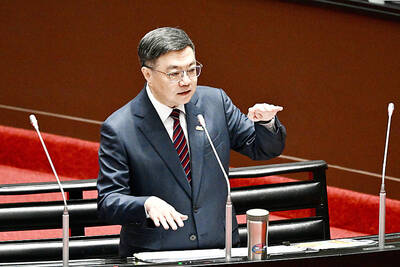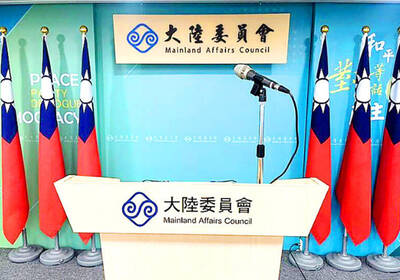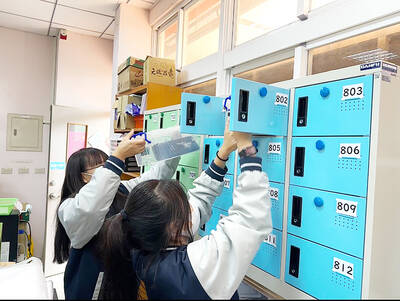A massive missile and drone attack destroyed one of Ukraine’s largest power plants and damaged others, Ukrainian officials said on Thursday, part of a renewed Russian campaign targeting energy infrastructure.
The Trypilska plant, which was the biggest energy supplier for the Kyiv, Cherkasy and Zhytomyr regions, was struck numerous times, destroying the transformer, turbines and generators, and leaving the plant ablaze.
As the first drone approached, workers hid in a shelter, saving their lives, said Andrii Gota, chairman of the supervisory board of the state company that runs the plant, Centrenergo.

Photo: Reuters
They watched the plant burn, surrounded by dense smoke and engulfed in flames.
“It’s terrifying,” Gota said.
Hours later, rescuers were still dismantling the rubble.
In Moscow, Russian President Vladimir Putin cast the attacks on Ukrainian energy facilities as a response to Ukrainian strikes that targeted Russian oil refineries.
The Trypilska plant supplied electricity to 3 million customers — but none lost power because the grid was able to compensate since demands are low at this time of year. Still, the consequences of the strikes could be felt in the coming months, as air-conditioning use ramps up in summer.
At least 10 other strikes overnight damaged energy infrastructure in Kharkiv. Ukrainian Minister of Foreign Affairs Dmytro Kuleba said more than 200,000 people in the region, which has been struck repeatedly, were without power.
Ukraine’s largest private energy operator, DTEK, described the slew of strikes as one of the most powerful attacks this year, while Ukrainian Minister of Energy Herman Halushchenko told reporters it was a “large scale, enormous, missile attack that affected our energy sector very badly.”
Russia’s renewed attacks on Ukrainian energy facilities last month blacked out large parts of the country — a level of darkness not seen since the first days of the full-scale invasion in 2022.
The volume and accuracy of the attacks have alarmed Ukrainians and left officials scrambling for better ways to protect energy assets. The strikes have also tested Ukraine’s ability to make quick repairs.
Kyiv’s leaders have pleaded for more air defense systems to ward off such attacks, but those supplies have been slow in coming.
“Today’s situation demonstrates that there’s nothing left to shoot down” the missiles, Gota said.

SEPARATE: The MAC rebutted Beijing’s claim that Taiwan is China’s province, asserting that UN Resolution 2758 neither mentions Taiwan nor grants the PRC authority over it The “status quo” of democratic Taiwan and autocratic China not belonging to each other has long been recognized by the international community, the Mainland Affairs Council (MAC) said yesterday in its rebuttal of Beijing’s claim that Taiwan can only be represented in the UN as “Taiwan, Province of China.” Chinese Minister of Foreign Affairs Wang Yi (王毅) yesterday at a news conference of the third session at the 14th National People’s Congress said that Taiwan can only be referred to as “Taiwan, Province of China” at the UN. Taiwan is an inseparable part of Chinese territory, which is not only history but

NATIONAL SECURITY: The Chinese influencer shared multiple videos on social media in which she claimed Taiwan is a part of China and supported its annexation Freedom of speech does not allow comments by Chinese residents in Taiwan that compromise national security or social stability, the nation’s top officials said yesterday, after the National Immigration Agency (NIA) revoked the residency permit of a Chinese influencer who published videos advocating China annexing Taiwan by force. Taiwan welcomes all foreigners to settle here and make families so long as they “love the land and people of Taiwan,” Premier Cho Jung-tai (卓榮泰) told lawmakers during a plenary session at the Legislative Yuan in Taipei. The public power of the government must be asserted when necessary and the Ministry of

CROSSED A LINE: While entertainers working in China have made pro-China statements before, this time it seriously affected the nation’s security and interests, a source said The Mainland Affairs Council (MAC) late on Saturday night condemned the comments of Taiwanese entertainers who reposted Chinese statements denigrating Taiwan’s sovereignty. The nation’s cross-strait affairs authority issued the statement after several Taiwanese entertainers, including Patty Hou (侯佩岑), Ouyang Nana (歐陽娜娜) and Michelle Chen (陳妍希), on Friday and Saturday shared on their respective Sina Weibo (微博) accounts a post by state broadcaster China Central Television. The post showed an image of a map of Taiwan along with the five stars of the Chinese flag, and the message: “Taiwan is never a country. It never was and never will be.” The post followed remarks

Proposed amendments would forbid the use of all personal electronic devices during school hours in high schools and below, starting from the next school year in August, the Ministry of Education said on Monday. The Regulations on the Use of Mobile Devices at Educational Facilities up to High Schools (高級中等以下學校校園行動載具使用原則) state that mobile devices — defined as mobile phones, laptops, tablets, smartwatches or other wearables — should be turned off at school. The changes would stipulate that use of such devices during class is forbidden, and the devices should be handed to a teacher or the school for safekeeping. The amendments also say